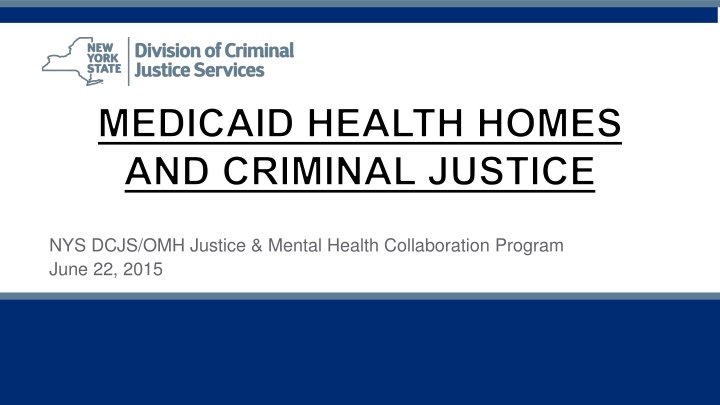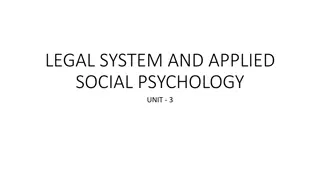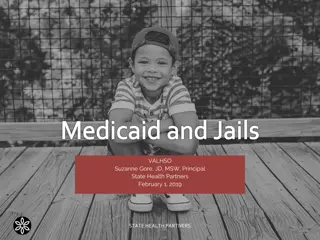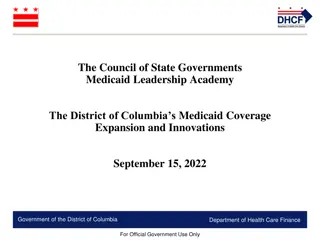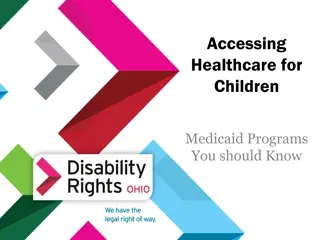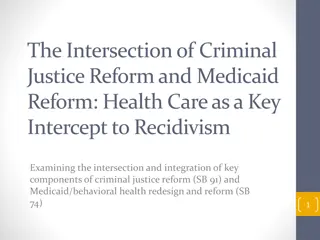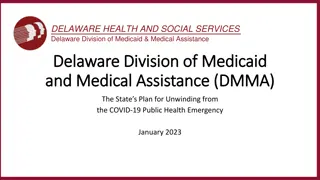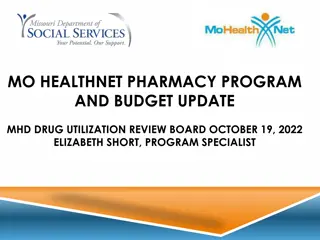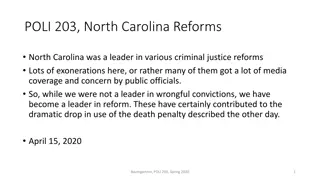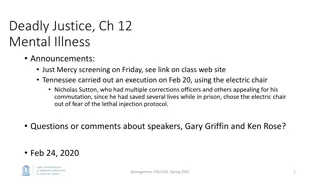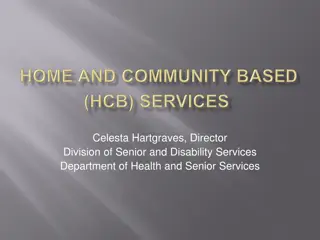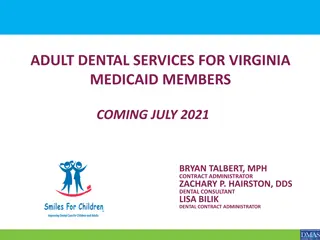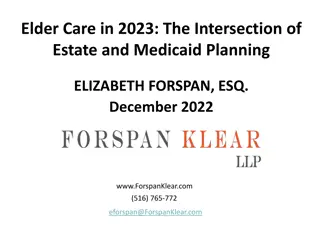Intersection of Medicaid Health Homes and Criminal Justice: Collab Program
Addressing the intersection of Medicaid health homes and criminal justice, the program aims to provide access to healthcare for justice-involved individuals, supporting recovery and meeting shared goals for better health, public safety, and reduced recidivism. The initiative involves collaborative efforts between Counties, Health Homes, and Criminal Justice Entities to promote pro-social behavior and well-being.
Download Presentation

Please find below an Image/Link to download the presentation.
The content on the website is provided AS IS for your information and personal use only. It may not be sold, licensed, or shared on other websites without obtaining consent from the author.If you encounter any issues during the download, it is possible that the publisher has removed the file from their server.
You are allowed to download the files provided on this website for personal or commercial use, subject to the condition that they are used lawfully. All files are the property of their respective owners.
The content on the website is provided AS IS for your information and personal use only. It may not be sold, licensed, or shared on other websites without obtaining consent from the author.
E N D
Presentation Transcript
MEDICAID HEALTH HOMES AND CRIMINAL JUSTICE NYS DCJS/OMH Justice & Mental Health Collaboration Program June 22, 2015
2 June 22, 2015 JMHCP--Intersection of Medicaid HH and Criminal Justice Addressing physical and behavioral health needs and ensuring justice involved individuals have access to healthcare, promotes pro-social behavior and recovery In turn, this supports the goals of the Medicaid Redesign for better health and lower costs, and criminal justice goals for greater public safety and reduced recidivism These presentations are intended to provide examples and resources for Counties, Health Homes and Criminal Justice Entities as they work together to support recovery and meet their goals
3 June 22, 2015 Webinar Audience DCJS JMHCP Pilot Counties Probation Directors, Mental Hygiene Commissioners and Jail Administrators Invitation is extended to: All Probation Departments, County Mental Hygiene Directors, Jail Administrators, ATI Programs and Health Homes New York City Department of Health and Mental Hygiene 19 DCJS funded County Re-Entry Taskforces
4 June 22, 2015 Webinar Participants Division Criminal Justice Services/Office of Probation and Correctional Alternatives Bernard Wilson, Program Manager, JMHCP Grant Margaret Schieferstine, Criminal Justice Program Representative, County Re-Entry Taskforces Department of Health, Division of Program Development and Management, Office of Insurance Programs Dr. Lynda Hohmann, Medical Director, Office of Insurance Programs Joann Susser Health Program Administrator, Office of Insurance Program Stephanie Fuertes, Student Intern NYS Conference of Local Mental Hygiene Directors Kelly Hansen, Executive Director Debra Holland, Director of Government Relations
5 June 22, 2015 DCJS JMHCP Webinar Agenda Introduction Valerie Chakedis, JMHCP Consultant Robert Maccarone, Deputy Commissioner DCJS/Director of the Office of Probation and Correctional Alternatives Wendy Vogel, Forensic Unit Chief, Bureau of Diversion, Reentry and Community Education, NYS Office of Mental Health DCJS Justice Mental Health Collaboration Program Robert Maccarone, Deputy Commissioner DCJS/Director of the Office of Probation and Correctional Alternatives Medicaid Health Homes Deirdre Astin, Program Manager, Health Home Program, Division of Program Development & Management, NYS Department of Health Monroe County Medicaid Health Home-Criminal Justice Pilot Program Robert Lebman, President & Chief Executive Officer, Huther Doyle and Rodney Corry, Chief, Priority and Socio-Legal Services, Monroe County
6 June 22, 2015 Webinar Agenda (continued) Phase I JMHCP County Schenectady Health Home Criminal Justice Collaboration Darin Samaha, Director of the Office of Community Services, Schenectady County Questions Resources
June 22, 2015 6 JMHCP Pilot Site Selection Violent Crime 2011 Count OMH 2010-11 Medicaid MH Costs: Individuals with High Utilization: $2 - $4,000 plus/month OMH 2010-11 Medicaid MH Costs including OASAS: Individuals with High Utilization: $2 - $4,000 plus/month Violent Crime 2011 Rate per 100,000 Implementation Phase 2010 IMPACT Counties: Population Albany Broome Chautauqua Dutchess 2 295,267 191,892 131,411 291,541 895,158 724,942 1,344,303 211,650 228,059 449,339 383,475 154,087 298,092 151,036 1,511,183 179,764 948,303 1,161 521 301 623 4,201 2,654 2,226 811 548 1,656 979 485 552 687 2,213 335 2,451 379.9 258.6 222.1 208.5 455.1 355.0 165.4 373.0 232.3 353.0 261.4 302.8 176.3 442.0 147.5 182.7 257.1 79 41 25 74 160 175 119 43 61 77 68 12 34 19 214 36 250 183 119 67 178 423 446 261 122 150 223 194 42 82 62 509 96 613 Erie 2 1 1 2 Monroe Nassau Niagara Oneida Onondaga Orange Rensselaer Rockland Schenectady Suffolk Ulster Westchester 2 2 1 1 1 8,389,502 1,487 3,770
8 June 22, 2015 Sequential Intercept Model Behavioral Health System CriminalJustice System Intercept 2 Intercept 3 Intercept 4 Intercept 1 Intercept 5 Criminal Justice System Post-arrest Court/Jail Re-entry from jail Pre-arrest Law Enforcement/ Emergency Services Probation / Parole Initial hearings/ Initial detention Special jurisdiction courts Transitional support back to community Community support services Diversion of appropriate adults throughout CJ system Community Services and Supports: BH crisis support, residential and vocational support, case management, treatment System
9 June 22, 2015 Intercept 1 Pre-arrest Intercept 2 Post-arrest Intercept 3 Court/Jail Intercept 4 Re-entry Criminal Justice System Intercept 5 Probation / Parole Law Enforcement / Emergency Services Initial hearings / Initial detention Special jurisdiction courts Transitional support back to community Community support services Jails/Courts Re-Entry Community Corrections Dashboard Measures Law Enforcement Initial Detention # of people screened at jail for SMI and/or co- occurring disorders # of people referred for mental health assessment # of people with SMI and/or co-occurring disorders engaged in treatment in jail # of people with SMI and/or co-occurring disorders released from jail with a discharge plan # of jail admissions shared with the county mental health service agencies # of agencies receiving jail admission data # of EDP incidents responded to by Police EDP incidents-# of Injuries sustained by civilians police EDP incidents- time required for police response # of people screened pre- arraignment for SMI and/or co- occurring disorders # of people referred for mental health assessment # probationers screened and identified as having SMI # individuals with SMI on specialized caseloads # and % individuals with SMI successfully completing specialized supervision # and % individuals stepped down from specialized supervision # of peer specialist groups held # and % of probationers with MI completing peer specialist groups # of consumers completing a subjective individual survey tool # of First Responder Forums held # of First Responder agencies participating # issues identified- addressed
10 June 22, 2015 JMHCP Technical Assistance INTERCEPT 1 LAW ENFORCEMENT EDPRT (Emotionally DisturbedPersons Response Team) This Critical Incident Training program is designed to develop police officers effective communication with persons with Serious Mental Illness (SMI), provide information regarding mental illness and offer technical assistance to police departments to develop departmental procedures for responding to incidents involving persons with SMI. First Responders Forum First Responder Meetings focused on developing mutual goals and practices involving the response to persons with SMI. The First Responders Forum includes representatives from police, fire, EMS, hospital emergency, and mental health providers. One of the Primary Goals is to reduce total police time required to safely and effectively respond to incidents. INTERCEPT 2 INITIAL DETENTION Pretrial Screening and Identification of Individuals with SMI Training to probation and private agency pretrial service programs in the use of standardized screening instruments to identify individuals with mental illness and co-occurring disorders following arrest. INTERCEPT 3 JAILS/COURTS Screening and Identification of Individuals with SMI Offer training in the use of standardized screening instruments to identify individuals with SMI and/or co-occurring disorders. Jail/Mental Health Information Sharing Provide technical assistance on information sharing models between jail facilities and mental health treatment professionals/agencies. INTERCEPT 4 RE-ENTRY Discharge Planning and Linkage to Community-Based Treatment Technical assistance and training to improve coordination between the jail and mental health clinicians in preparing inmates for discharge. INTERCEPT 5 COMMUNITY CORRECTIONS Probation Mental Health Specialized Supervision Cross training of probation and mental health professionals to supervise/manage probationers with SMI and/or co-occurring disorders. Credential probation officers as supervision specialists. Probation, Mental Health and Peer Specialist Supervision Groups Offer technical assistance to implement peer advocacy supervision model leading to better outcomes supporting recovery. ADDITIONALJMHCP TECHNICAL ASSISTANCE Community Care Coordination A program that ensures access to high quality services and promotes recovery using a Care Coordinator who creates and supports implementation of Individualized Service Plans. There have been demonstrated cost savings with this program in Westchester County.
11 June 22, 2015 JMHCP Expansion Grant April 2015 submitted proposal to BJA for a JMHCP expansion grant for additional 5 counties October earliest possible start date If awarded, OPCA will: Add 5 more counties Increase technical assistance Offer new technical assistance in the areas of: Job readiness, employment and retention Risk, need and responsivity training for criminal justice and treatment providers
NEW YORK STATE HEALTH HOMES: CARE MANAGEMENT FOR THE CRIMINAL JUSTICE INVOLVED POPULATION Deirdre Astin, New York State Department of Health Office of Health Insurance Programs
13 June 22, 2015 What is a Health Home? Section 2703 of the Affordable Care Act (ACA) authorized an optional Medicaid State Plan benefit to establish Health Homes to coordinate care for people with Medicaid who have chronic conditions. Health Homes provide comprehensive, integrated, person-centered care management and coordination to Medicaid enrollees with complex needs through a network of medical, behavioral health, and social service providers.
14 June 22, 2015 14 New York State Health Home Model Health Homes must have connected under a single point of accountability all of the following: One or more hospital systems Multiple ambulatory care sites (physical and behavioral health) Community based organizations, including existing care management and housing providers Single Point of Accountability (Designated Lead HH) is responsible for governance and operations, development of standardized policies and procedures for care management across its network of providers.
June 22, 2015 15 New York State Health Home Model Managed Care Organizations (MCOs) New York State Designated Lead Health Home Administrative Services, Network Management, HIT Support/Data Exchange Health Home Care Management Network Partners (includes former OMH TCM, and HIV/AIDS COBRA Providers) Comprehensive Care Management Care Coordination and Health Promotion Comprehensive Transitional Care Individual and Family Support Referral to Community and Social Support Services Use of Health Information Technology to Link Services (Electronic Care Management Records) MAPP RHIO Access to Required Primary and Specialty Services (Coordinated with MCO) Physical Health, Behavioral Health, Substance Use Disorder Services, HIV/AIDS, Housing, Social Services and Supports
June 22, 2015 16 Health Home Vision HEALTH HOME CARE TODAY TODAY S CARE S CARE Our patients are those who are registered in our health home My patients are those who make appointments to see me Patients Patients chief complaints or chief complaints or reasons for visit determines care reasons for visit determines care We systematically assess all We systematically assess all our patients our patients health needs to plan care health needs to plan care Care is determined by a proactive plan to meet patient needs without visits Care is standardized according to evidence-based guidelines Care is determined by today Care is determined by today s s problem and time available today problem and time available today Care varies by scheduled time and memory or skill of the doctor Patients are responsible for coordinating their own care A prepared team of professionals coordinates A prepared team of professionals coordinates all patients all patients care care We measure our quality and make rapid changes to improve it Acute care is delivered by open access and non-visit contacts I know I deliver high quality care because I know I deliver high quality care because I I m well trained m well trained Acute care is delivered in the next available appointment and walk-ins We track tests & consultations, and follow-up after ED & hospital A multidisciplinary team works at the top of our licenses to serve patients It It s up to the patient to s up to the patient to tell us what happened to them tell us what happened to them Clinic operations center Clinic operations center on meeting the doctor on meeting the doctor s needs s needs
17 June 22, 2015 17 Health Home Care Management Services Health homes provide the following Health Home services in accordance with federal and State requirements: Comprehensive care management Care coordination and health promotion Comprehensive transitional care Patient and family supports Referral to Community and Social Support Services Use of Health Information Technology (HIT) to Link Services Health Home care management is an opportunity to link CJ involved individuals to systems of health, behavioral health and community care and supports to reduce disparities and recidivism rates.
18 June 22, 2015 18 New York State Health Home Population More than five million Medicaid members in New York State. 1.2 million individuals meet the Federal criteria for Health Homes. Target enrollment for NYS is 829,000 (prioritizing for highest risk). Over 140,000 individuals engaged to date There are 31 Health Homes serving all counties of the State (some Health Homes serve more than one county).
19 June 22, 2015 19 Who is Eligible to be Enrolled in a Health Home? Persons enrolled in Medicaid with: At least two chronic conditions One qualifying chronic condition: (HIV/AIDS) or one serious mental illness Chronic Conditions Include (but are not limited to): Mental Health condition Substance Use Disorder Asthma Diabetes Heart Disease BMI>25 (overweight or obese) Eligibility criteria to be expanded for children, to include trauma with risk for another condition 19
20 June 22, 2015 20 Criminal Justice: Health and Behavioral Health Disparities 53% Women & 35% Men involved in the criminal justice system report a current medical issue. (National Health Care For The Homeless 2013) 60-80% of all individuals under supervision have a substance use related issue. (SAMHSA 2013) 17% of all individuals under supervision have been diagnosed with a serious mental illness, of this 17%, 75% have a co-occurring disorder. (CSG 2013) 64% of all those in jail have some form of mental illness. (OJP 2013) 17% are either HIV+ or living w/AIDS. (National Health Care For The Homeless 2013) 20 20
21 June 22, 2015 Health Homes and Criminal Justice Pilots Pilot Site HHUNY Finger Lakes, Huther Doyle Project Partnership HHUNY Western, Lakeshore/ Horizon Bronx Lebanon Bronx Accountable Healthcare Network Coordinated Behavioral Care Community Healthcare Network Brooklyn Health Home
22 June 22, 2015 22 Common Themes to Date Each site is working with criminal justice partners to identify and engage formerly incarcerated individuals: Established partnerships with Correctional Facilities and Court Systems (Personnel) for early identification of potential candidates or current members incarcerated. E.g. One site has partnered with NYC DOHMH/Correctional Health Services, and another with the County DA and Court. Established data systems to track and monitor potential and current enrollees that are discharged from a facility, are admitted to a hospital, and/or have used the ER. One way Care Managers establish a trusting relationship with the individual is through engagement prior to release. E.g. One site has a Care Manager embedded within the jail Care Plans are developed with the enrollee that are centered on individuals needs and goals. Individual is motivated to take control of his/her care and wellness. 22 22 22
23 June 22, 2015 23 Challenges Medicaid enrollment and eligibility Delays in Medicaid enrollment verification High percentage of clients without insurance Data sharing and HIT connectivity Medicaid data is subject to strict federal and State protections Criminal justice agencies have not been allowed access for incarcerated Medicaid recipients Lack of sufficient resources Working with the State Prison System Mobility of incarcerated population Variability in release sites 23 23 23 23
24 June 22, 2015 24 Solutions: Data Sharing and Connectivity Confidentiality Agreement (OCFS + DOH) For connecting NYSID numbers with Medicaid data systems to facilitate outreach and enrollment of CJ involved individuals Medicaid Analytics Performance Portal (MAPP) development (OHIP) A web-based portal for greater data sharing and wide scale communication between DOCCS, DCJS, DOH/OHIP + Health Homes, MCO, CMAs, and CJ agencies Interagency MOU crafting for sharing of Medicaid Confidential Data (MCD) Working with the State Prison System for identification of linkages DOCCS has shared a de-identified cohort of 22,000 releases with OHIP to test and refine member-level data matching 24 24 24 24 24 24
25 June 22, 2015 25 Solutions: Resources Delivery System Incentive Program (DSRIP) $8 billion in federal MRT savings to achieve comprehensive reform of the healthcare safety net system Safety net providers will be required to form Performing Provider Systems (PPS), conduct Community Health Assessments to identify needs in CJ population, and select projects based on those needs; incentive payments contingent on meeting goals. Health Homes are an opportunity to address disparities in the care of the criminal justice involved population. Executive Budget includes $5 million in 2015-16 and 2016-17 to establish linkages between Health Homes and Criminal Justice system 25 25 25 25 25 25 25
26 June 22, 2015 Resources Visit the Health Home Website: https://www.health.ny.gov/health_care/medicai d/program/medicaid_health_homes/
27 June 22, 2015 Monroe County: Initiatives and CJ-HH Pilot Robert Lebman, MA President & CEO Huther Doyle Rodney Corry, MA, LMHC Monroe County, Chief, Priority and Socio-Legal Services Craig Johnson, LMHC, CASAC-G Supervisor,Behavioral Health Programs, Monroe County Monroe County Correctional Facility
28 June 22, 2015 CJ HH Pilot lessons Monroe County Purpose Brief overview of MH/CJ collaborative activities in Monroe County (pop. 750,000) Organized into regular activities and special projects Highlight opportunities for connections between various community initiatives
29 June 22, 2015 CJ HH Pilot lessons Monroe County Regular activities Criminal Justice/Mental Health Committee MCSO; Jail; RPD; Courts; Probation; Parole; District Attorney; Public Defender; RFU; NAMI; Veterans Outreach; MCOMH Emergency Services Committee CPEP & ED; Mobile Crisis; Detox; MCSO; Jail; RPD; 911;EMS; OPWDD; START; MCOMH Multi-Jurisdictional Crisis Intervention Task Force All police jurisdictions and two area colleges Forensic Committee at Rochester Psychiatric Center RFU, RPD, MCSO
30 June 22, 2015 CJ HH Pilot lessons Monroe County Regular activities (continued) EDPRT Trainings for new police officers Week long annual training for new classes Info about mental health, mental hygiene law, other behavioral health topics MCOMH on call process for clinical consultation to sheriff/police Real time advisement as incidents occur Evening and weekends Transition Management in MH Court
31 June 22, 2015 CJ HH Pilot lessons Monroe County Special Projects DCJS grant Sequential mapping exercise Technical assistance re: probation peer groups MH/Jail Data matching project automated process to match new jail admissions with mental health service utilization data to inform jail staff and current providers (implemented March 2015) Trauma Informed Practices consultation and training for all jail staff Scheduled for Fall 2015
32 June 22, 2015 CJ HH Pilot lessons Monroe County Health Home Pilot to date Care Manager assigned part-time to County Jail Works with facility staff to identify eligible inmates 3 months pre-release Does assessment and ascertains interest Identifies re-entry needs: housing, insurance, primary care, mental health/substance abuse, vocational/educational .... Develops interim plan with inmate
33 June 22, 2015 CJ HH Pilot lessons Monroe County Pilot continued Post release: assists in opening/reactivating Medicaid Enrolls released inmate in Health Home Implements Care Plan and provides necessary support
34 June 22, 2015 CJ HH Pilot lessons Monroe County Pilot evolving Discussions underway to implement Vivitrol induction pre-release for appropriate inmates Presentations have been made to Assistant DAs: Health Home services; Vivitrol Individuals who may be eligible for Health Home and who have a drug use history will be identified at arraignment Health Home Care Manager will be assigned to Drug Court, DWI Court and Mental Health Court
35 June 22, 2015 CJ HH Pilot lessons Monroe County PilotEvolving (continued) Comprehensive Assessment will be completed and Care Plan developed Care Manager will make regular reports to the Court and/or Probation District Attorney will arrange presentations to Bar Association and Judges to expand model across criminal justice system Re-entry Task Force will place Care Manager in area state facility and replicate Monroe County Jail model
36 June 22, 2015 CJ HH Pilot lessons Monroe County Future Work Health Home lead agency, Correctional staff and Monroe County Socio- Legal will begin meeting to identify areas where information should/can be shared and services coordinated The potential for collaborating to track and measure outcomes will be explored
37 June 22, 2015 Schenectady County Collaboration: Mental Health, Criminal Justice and Health Home Darin Samaha, LCSW-R Director of Community Services Schenectady County
38 June 22, 2015 Schenectady County Overview of MH/CJ collaborations in Schenectady County (pop. 155,000) Schenectady County JMHCP Phase 1(January 2014) Changing Environment - Changing strategies (building the plane as it s flying)
39 June 22, 2015 Schenectady County Collaboration pre JMHCP Mental Health Courts (City and County) Trauma Trainings SPOA County Re-Entry Taskforce Probation, Mental Health and Peer Specialist Supervision Groups Tweaking the model Specialized Mental Health Probation Officers Executive Leadership Committee
40 June 22, 2015 Post JMHCP and Jail MH Grant Sequential intercept mapping (SIM) Veterans-Track Mental Health & Substance Abuse training for Public Defenders and District Attorney s Office Mental Health Jail Grant Emotionally Disturbed Persons Response Team (EDPRT)
41 June 22, 2015 Continued SAMHSA GAINS Center Trauma Informed Law Enforcement Training 11thCounty Starting Regional Adult Mobile Crisis Team Target Population Jail/Prison Discharge
42 June 22, 2015 Jail Mental Health Grant Inmate Services Coordinator Peer Mentors Pre/Post Release Probation/Peer Transition Group Health Home / Forensics Linkage
43 June 22, 2015 History of Strong Cross Systems Collaborations Eventful 2014 Crises and Community Response Suicide contagion Hurricane Irene and Tropical Storm Lee Fires - 50 people homeless Nationally Reported Suicide
44 June 22, 2015 Schenectady Care Coordination and Health Home Linkages Leadership Changes Addressing System Gaps Schenectady Problem Solving Model Based on SIM
45 June 22, 2015 Schenectady Forensic Workgroup - June 16, 2015 All stakeholders involved with jail releases Meeting to address gaps and overlaps in the system Establish protocols to better coordinate resources and services E.g. - Define problems such as: reactivation of Medicaid as soon as possible; provide for adequate medication until intake assessment in the community; create a release checklist; develop list of other issues or problems to resolve and subgroups as needed Next steps - formalize group into Behavioral Health- Criminal Justice workgroup
46 June 22, 2015 JMHCP Questions?
47 June 22, 2015 Handouts Mapping the Criminal Justice System to Connect Justice-Involved Individuals with Treatment and Health Care under the Affordable Care Act, Bureau of Justice, National Institute of Corrections, Lore Joplin, June 2014 The Affordable Care Act and Criminal Justice: Intersections and Implications, Andrea A. Bainbridge, Bureau of Justice Assistance, U.S. Department of Justice, July 2012 The Stepping Up Initiative: A National Initiative to Reduce the number of People with Mental Illnesses in Jails, Council of State Governments (CSG) and the National Association of Counties (NaCO) The Affordable Care Act and County Jails: A Practical Guide to Strategies and Steps for Implementation, Denver Sheriff s Department, Sheriff Gary Wilson, December 2013 Health Coverage and County Jails: Suspension vs Termination, National Association of Counties (NaCO), December, 2014 Ten Ways Corrections Systems Can Help Link Returning Offenders to Health Insurance, HealthCare.gov Health Homes Survey of the County Re-Entry Taskforces, DCJS/OPCA June 2015
48 June 22, 2015 Resources New York State Department of Health Health Home website http://www.health.ny.gov/health_care/medicaid/program/medicaid_health_homes/ Federal ACA Website https://www.healthcare.gov/incarcerated-people/ Pennsylvania response to ACA - website http://www.pacenterofexcellence.pitt.edu/ACA.html Website for state information on criminal justice and health care https://www.statereforum.org/node/9737 Study of health care and public safety http://www.arnoldfoundation.org/researchers-study-affordable-care-act s-impact-public-safety Stepping Up: A National Initiative to Reduce the Number of People with Mental Illnesses in Jails https://stepuptogether.org
